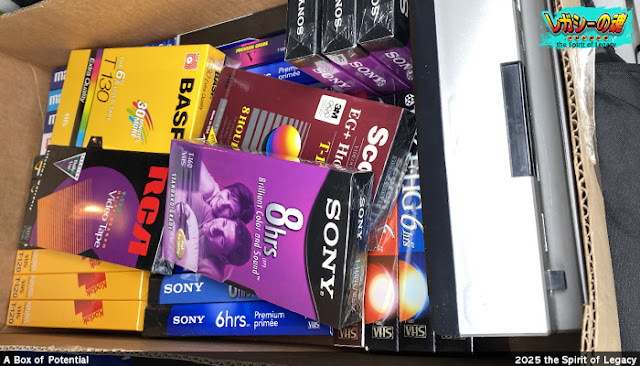 |
| The more time passes, the more facts as well as media recorded on VHS becomes more blurry. |
Something I've been asked a lot since I started this media archiving effort, is "How long do VHS cassettes last?"
The answer isn't simple, but it is pretty well summed up as "Not long enough." Especially if it's viewed as something to be handed down, viewed often, or expected to be around and playable along with VCRs.
So let's take a look at the age, history, and functionality of the media platform of VHS cassettes.
The late 70s into the early 80s...
Here in the United States, we got three film releases on VHS in 1977. "Patton", "Sound of Music" and "M*A*S*H" were all simultaneously released from the company Magnetic Video at prices ranging from $50 to $70 each.
As of the posting of this, that means that a lot of VHS cassettes that came out, if they are still around are nearing the 50 year mark. Including some of the original blank videocassettes, which also made their debut in 1977, manufactured by JVC.
The first affordable stand alone personal video recorders that could use VHS came out around late 1983, which sets the standard for the age of some of the oldest directly recorded family memories on VHS media to be at the most 42 years old.
In 1978, JVC released VCRs with A/V inputs on them, allowing as some families I knew personally did, to set up projectors to play back 8/16/35mm reels and allow the projection to be recorded via video camera and to the VCR, or some years later, directly to the onboard VHS in the videocamera.
Technical difficulties through the 90s...
One of the touted aspects of VHS was it's widespread access to an ever growing catalog of commercial movie releases and the ability to store memories and record anything you wanted that was broadcast or at the other end of your video camera lens. This led to a booming market for audio/video equipment to record and playback whatever you filmed. For a good solid 15 years, the platform of VHS reigned supreme, overtaking others like LaserDisc and the earlier format, BetaMax.
But was it sustainable?
The science behind videocassettes is similar to audio cassettes and the much earlier format size of reel to reel, in that they utilize magnetic tape to capture sound and in the case of VHS, video.
Initial listening and watching of magnetic tape can indeed showcase superior sound and display, but with every replay, with each rewinding, or every over recording in the case of blank tapes, things begin to change.
The magnetic array will begin to lose clarity both in audio and in video presentation. Some of this is from wear and tear, some of this is loss of the magnetic particles from the tape itself leading to a degrading action called "shedding", which can further damage not only the video cassette but your vcrs or old video cameras.
Marketing of the era certainly promoted VHS to be a fantastic product. One that could store and keep investments of moments and movies you loved, nearby and safe in your living room, or to send to others.
 |
| I never got this when it originally came out. $60 was a LOT of money. |
Whether the makers of VHS knew or not, the simple fact of the matter was that even under the best of circumstances, the nature of the manufacturing process means that even sealed copies of VHS, if opened today, have a fairly high chance of not working correctly.
Depending on how it was stored, if there are plastic or mechanical part failures, and many other issues that can be problematic for a format that was seen as something that worked for that time as the technological marvel that it was.
A new format and a second chance at life...
In 1997, the DVD format came onto the scene. By 2003 it had overtaken the sales and place of VHS in retail and rental outlets. It also became the next format to inherit the place of keeping data of all kinds, including videos, safe and secure. All on a highly portable and storable medium that seemed far more reliable and longer lasting.
Manufacturing standards and time have shown that DVDs have a very good shot at being a way to save earlier media from films to digital video, music, photos, really almost anything... for anywhere from 30 years to upwards of 100 years.
I started this effort up because I had a lot of older video and photos I wanted to digitize and save for posterity, for books yet written, and YouTube Channel content I plan to produce.
Now, I'm offering this out to people as a service to help preserve what memories you have on VHS and VHS-C formats on a far more stable media.
If you're interested or have further questions, please check out the pricing page!
- Mario, the Artisan Rogue
















